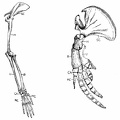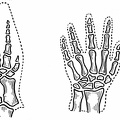An atom is the smallest particle of a chemical element. Two or more atoms come together to form a molecule: thus molecules form the mass of matter. A molecule of water is made up of two atoms of hydrogen and one atom of oxygen. Molecules of different substances, therefore, are of different sizes according to the number and kind of the particular atoms of which they are composed. A starch molecule contains no less than 25,000 atoms.
Molecules, of course, are invisible. The above diagram illustrates the comparative sizes of molecules.
- Author
- The Project Gutenberg EBook of The Outline of Science, Vol. 1 (of 4), by J. Arthur Thomson
Published in 1922
Available from gutenberg.org - Posted on
- Friday 17 July 2020
- Dimensions
- 1200*892
- Tags
- Albums
- Visits
- 924
- Downloads
- 29
 Download Photo
Download Photo





